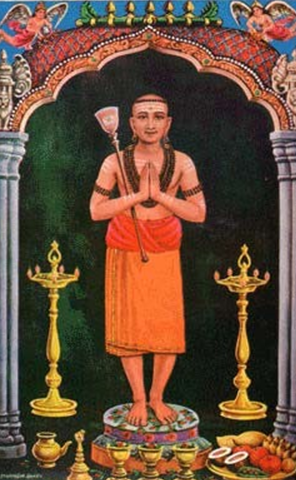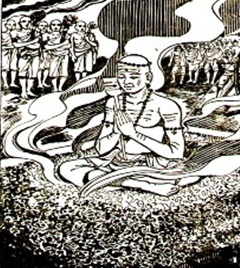Talk:The Nāyaṉmār Saints:Appār
By Vishal Agarwal
Born in the 7th century A.D., he is considered one of the most prominent of the sixty-three Nayanār. His childhood name was Marulneekiar, meaning “the dispeller of darkness or ignorance.” Even at a young age, Appār was very charitable.
In his youth, he became inspired by Jainism and its practice of ahiṃsā. His sister, Tilakavathiar, was heartbroken over this change in her brother and prayed to Bhagavān Śiva to reconvert Appār to Śaivism. Bhagavān Śiva gave Appār a severe stomachache, which the Jains were unable to cure. His sister took him to a Śiva temple and gave him holy ash. When Appār applied the ash and sang in praise of Śiva, the pain disappeared. A divine voice from the sky declared, “From now on you will be known as Thirunavukkarasar (Bhagavān of Speech). Your glory will spread everywhere.” Appār thus became a Śaivite again.
The Pallava king of the time disapproved of Appār’s reconversion to Śaivism. He ordered that Appār be thrown into a burning lime kiln. Appār was shut inside for seven days, but he remained there, fixing his mind on the Bhagavān and repeating Śiva’s name. By Śiva’s grace, the heat of the kiln was transformed into a cool breeze.
The king then ordered that Thirunavukkarasar (Appār) be tied to a stone and thrown into the sea. Appār sang hymns in praise of the Pañchākṣara Mantra, ‘‘Om Namaḥ Śivāya.’’ As soon as he finished the song, the stone began to float on the water, and Appār was saved from drowning.
Hearing of Sambandhar, he went to Sirkali to meet him. Sambandhar respectfully addressed Thirunavukkarasar as ‘Appār,’ meaning “father.” Thereafter, he and Appār travelled together, singing hymns.
Appār is said to have travelled to about 125 temples in different cities and villages of Tamil Nadu. He attained liberation at Pukalur in Tamil Nadu at the age of eighty-one. About 3,120 of his verses in praise of Śiva survive today.
Appār is always depicted as carrying a hoe a long-handled gardening tool. During his lifetime, he visited numerous temples and public places, and was saddened to see their pathways dirty and overgrown with weeds. Wherever he went, using his hoe, he would lovingly clean the pathways.
The Saint’s example teaches that we should keep our places of worship and other public areas clean, and must not hesitate to perform sevā to tidy them when needed. [1]If a great saint like Appār could do such manual work, we too must never feel that we are too superior to do it.
References[edit]
- ↑ Nandakumar, Prema. Saints of Saivism. Sri Ramakrishna Math, 2013, p. 93.


